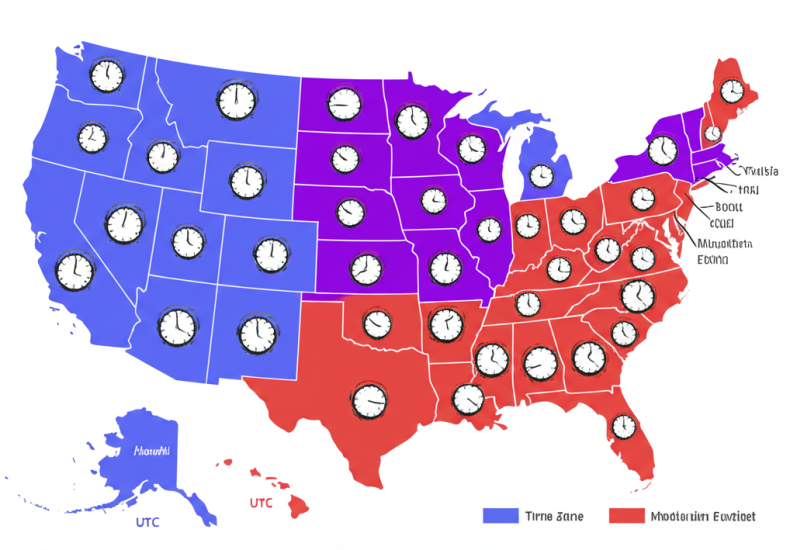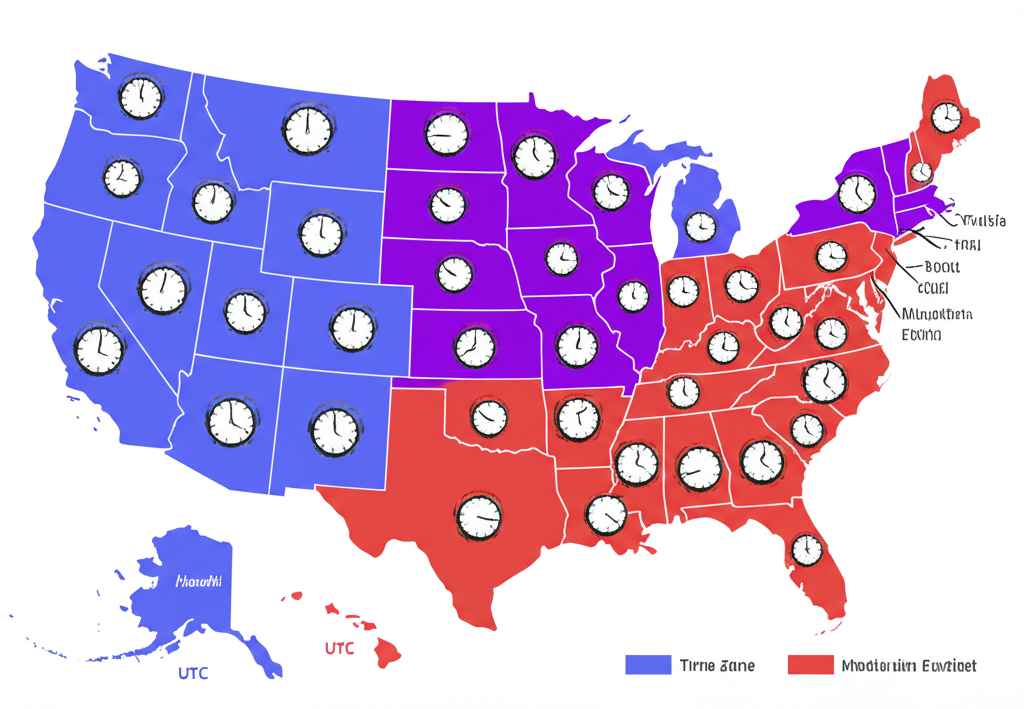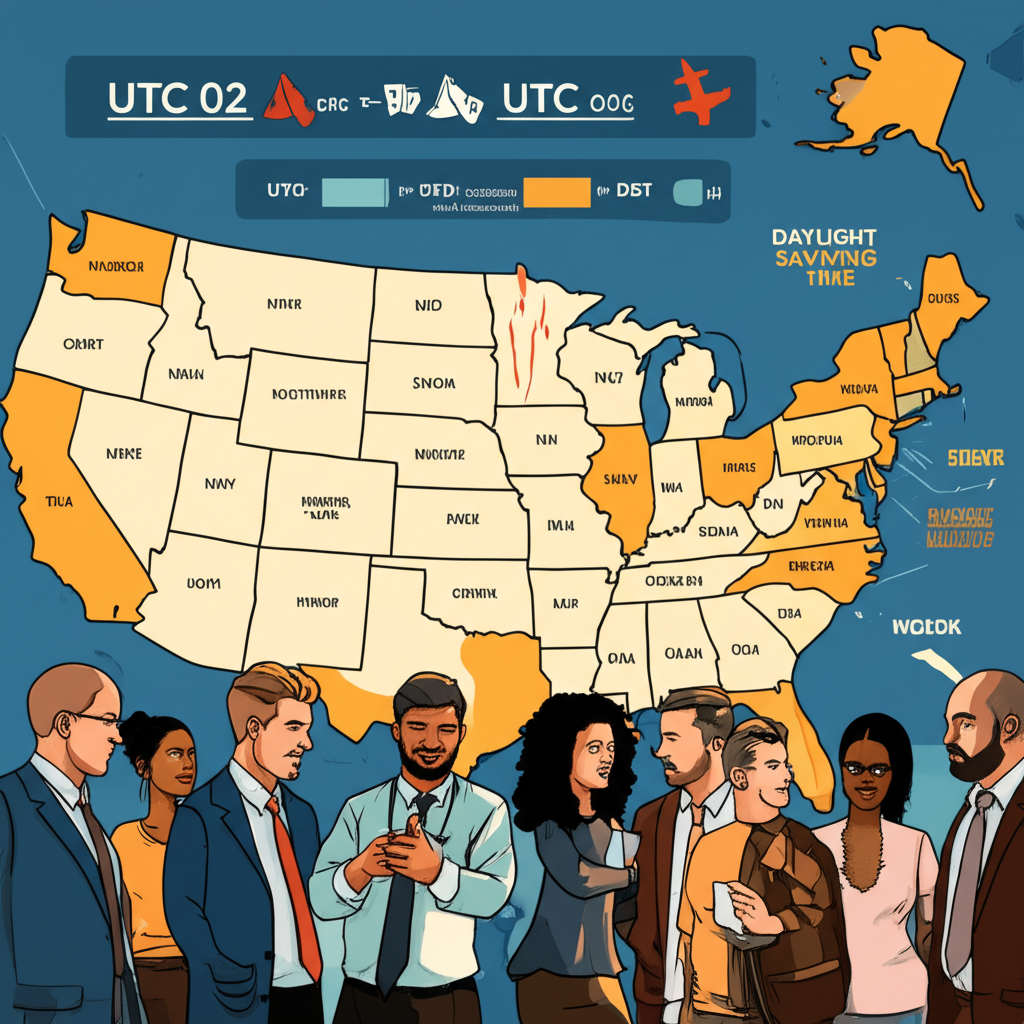
US Time Zones Explained: Your Essential Guide to Navigating 6 American Time Zones
Table of Contents
ToggleWhat Time Is It Right Now in the United States?

The United States spans multiple time zones, making the concept of a single “current time” a bit more complex than in smaller nations. Depending on where you are—from the bustling East Coast to the remote islands of Hawaii—the clock could show a time several hours apart from another region. This variation stems from the country’s immense east-to-west expanse, which crosses thousands of miles and creates natural differences in sunrise and sunset times. As a result, the U.S. is divided into six primary time zones across its states, each aligned with Coordinated Universal Time (UTC) at different offsets. While the exact time in any given location shifts with Daylight Saving Time, understanding the framework of these zones is essential for everything from scheduling calls to planning travel. For real-time accuracy, digital tools and official sources like Time.gov offer live updates synchronized with atomic clocks.
Understanding the Major US Time Zones

To maintain consistency across a nation that stretches nearly coast to coast, the U.S. has adopted a standardized time zone system. This structure ensures that businesses, transportation networks, and government operations can function efficiently despite geographical distance. The Department of Transportation oversees these zones, which are defined by federal regulation and based on longitudinal divisions. Each zone follows a fixed offset from UTC, which adjusts seasonally in most areas due to Daylight Saving Time. This system, though now deeply embedded in daily life, was not always in place—its origins lie in the practical needs of 19th-century rail travel. Today, it supports everything from national broadcast schedules to international business coordination, making it a cornerstone of modern American infrastructure.
Eastern Time Zone (ET): States and Key Cities

The Eastern Time Zone covers the most populous region of the United States and serves as the nation’s economic and political heartbeat. It includes major metropolitan areas such as New York City, Washington D.C., and Miami, where financial markets open and federal decisions are made. During standard time, this zone operates at UTC-5, known as Eastern Standard Time (EST). When Daylight Saving Time begins in March, clocks shift forward one hour to UTC-4, marking the start of Eastern Daylight Time (EDT). This adjustment extends evening daylight, supporting energy efficiency and after-work activity. The zone includes a wide range of states from Maine down the Atlantic coast to Florida, and westward through Ohio, Michigan, and parts of Indiana and Kentucky. Its influence on national timekeeping is so strong that ET is often used as a reference point in media and broadcasting.
Central Time Zone (CT): States and Key Cities

West of the Eastern Zone lies the Central Time Zone, a vast region that stretches from the Gulf Coast up through the Great Plains and into the Upper Midwest. This area, which follows Central Standard Time (CST) at UTC-6 and shifts to CDT (UTC-5) during Daylight Saving Time, plays a critical role in the nation’s agricultural output and industrial production. Cities like Chicago, the third-largest in the U.S., serve as transportation and financial hubs, while Houston anchors the energy sector and New Orleans contributes to cultural and maritime commerce. The zone includes states such as Texas, Illinois, Missouri, and Minnesota, with some states like Tennessee and Kentucky split between Central and Eastern times. This division can sometimes cause confusion, especially for travelers crossing state lines, but local signage and digital devices typically reflect the correct time automatically.
Mountain Time Zone (MT): States and Key Cities
The Mountain Time Zone spans the rugged western interior of the country, encompassing the Rocky Mountains and parts of the high desert. It operates at UTC-7 during standard time (MST) and shifts to UTC-6 (MDT) when Daylight Saving Time is active. One notable exception is Arizona, which remains on MST year-round and does not observe DST—though the Navajo Nation within its borders does follow the seasonal change. This creates a unique situation where parts of the same state can be on different times during summer months. Key cities in this zone include Denver, Salt Lake City, and Phoenix, each serving as regional centers for government, technology, and tourism. The landscape here influences lifestyle, with outdoor recreation and energy sectors thriving under long summer days. Despite its name, not all of Montana or Wyoming falls within this zone, and small portions of Oregon, Idaho, and Nevada also observe Mountain Time.
Pacific Time Zone (PT): States and Key Cities
Occupying the western edge of the contiguous United States, the Pacific Time Zone is home to some of the nation’s most influential cities in technology, entertainment, and international trade. It follows Pacific Standard Time (PST) at UTC-8 and switches to Pacific Daylight Time (PDT) at UTC-7 during the warmer months. This zone includes California, Washington, Oregon (most), Nevada (except for a small eastern portion), and the northern tip of Idaho. Major urban centers like Los Angeles, San Francisco, and Seattle drive innovation and culture, while ports such as those in Long Beach and Seattle facilitate global commerce. The time difference between PT and the East Coast means that when the workday begins in New York, it’s still early morning on the West Coast, affecting everything from stock market activity to live television broadcasts. This staggered schedule allows for extended business hours across the country, benefiting customer service and media distribution.
Alaska and Hawaii Time Zones: AKST & HST
Beyond the lower 48 states, Alaska and Hawaii operate on their own distinct schedules. Alaska Time (AKST) is set at UTC-9 during standard time and shifts to AKDT (UTC-8) during Daylight Saving Time. Most of the state observes this change, though the westernmost Aleutian Islands follow Hawaii-Aleutian Standard Time. Anchorage and Juneau, the largest cities, align with this system, which accounts for extreme seasonal variations in daylight. Hawaii, on the other hand, remains on Hawaii Standard Time (HST) year-round at UTC-10 and does not observe Daylight Saving Time. This decision, shared only with Arizona among U.S. states, simplifies timekeeping in a remote island chain where sunrise and sunset times vary less dramatically throughout the year. Honolulu, the state capital, runs on this consistent schedule, making it a reliable reference for Pacific regional coordination.
For a comprehensive overview of time zones and their current offsets, the U.S. Department of Transportation provides official information on its website here.
Daylight Saving Time (DST) in the USA: When and Why
Daylight Saving Time is observed across most of the United States as a way to extend usable daylight in the evenings during the longer days of spring and summer. The practice involves moving clocks forward by one hour in the spring—”springing forward”—and setting them back in the fall—”falling back.” This shift aims to reduce energy consumption by minimizing the need for artificial lighting, a rationale that gained traction during World War I when the U.S. first adopted the measure nationally. Today, DST begins on the **second Sunday in March** at 2:00 AM local time and ends on the **first Sunday in November** at the same hour. In 2024, for example, the change occurred on March 10th and will conclude on November 3rd. While most states follow this schedule, exceptions exist: **Hawaii** and most of **Arizona** opt out entirely, maintaining their standard time year-round. Additionally, U.S. territories such as Puerto Rico, Guam, and the U.S. Virgin Islands do not participate. The Uniform Time Act of 1966 established this framework, allowing states the option to exempt themselves while ensuring national consistency otherwise. More details on the history and regulations of Daylight Saving Time can be found on official government resources such as the National Institute of Standards and Technology (NIST) website here.
Converting “USD Time”: Your Interactive Time Zone Converter
The term “USD time” frequently appears in search queries, often stemming from a confusion between “USD,” the currency code for the U.S. dollar, and the desire to know the current time in the United States. Despite the misnomer, the intent is clear: users want to quickly determine what time it is across various U.S. regions or convert it to their local time. Given the complexity of six different time zones and the seasonal impact of Daylight Saving Time, manual calculation can be error-prone. An interactive time zone converter solves this challenge by offering real-time synchronization across global locations. These tools allow users to select a U.S. city—like New York, Chicago, or Los Angeles—and instantly view its current time alongside any other location worldwide. They automatically adjust for DST, eliminating the need to manually track seasonal changes. Whether scheduling a meeting, tracking a shipment, or calling a family member, these converters provide a seamless, accurate experience. Many are integrated into calendar apps, websites, and smart devices, making them accessible to both individuals and businesses.
How US Time Zones Impact International Communication and Travel
The broad geographic reach of the United States creates a unique challenge for global interactions. With up to six hours separating its time zones—and an even greater gap when including international locations—coordinating across borders requires careful planning. This is especially true for business professionals, remote teams, and travelers who must navigate overlapping work hours, jet lag, and scheduling nuances. The addition of Daylight Saving Time further complicates matters, as the U.S. schedule doesn’t always align with that of other countries. For instance, Europe transitions in and out of DST on different dates, creating temporary mismatches in time differences. Understanding these dynamics helps prevent missed calls, delayed responses, and logistical errors.
USA Time Now in India: Bridging the Time Gap
The time difference between the United States and India is one of the most significant in international business. India operates on Indian Standard Time (IST), which is fixed at UTC+5:30 and does not observe Daylight Saving Time. This means India is always ahead of U.S. time zones, with the gap varying depending on the region and season. During U.S. Daylight Saving Time (spring to fall), the differences are as follows:
– **New York (EDT, UTC-4):** 9.5 hours behind India. When it’s 10:00 AM in New York, it’s 7:30 PM in India.
– **Chicago (CDT, UTC-5):** 10.5 hours behind. 10:00 AM in Chicago equals 8:30 PM in India.
– **Denver (MDT, UTC-6):** 11.5 hours behind. 10:00 AM in Denver is 9:30 PM in India.
– **Los Angeles (PDT, UTC-7):** 12.5 hours behind. 10:00 AM in L.A. corresponds to 10:30 PM in India.
This means that typical U.S. business hours often end just as the Indian workday begins. Successful coordination often involves early morning calls in the U.S. or late afternoon meetings in India. Tools like World Time Buddy or Google Calendar’s time zone feature help identify overlapping windows, while setting meeting times in UTC can eliminate ambiguity. Clear communication—such as specifying “10:00 AM EDT” instead of just “10:00 AM”—is essential to avoid confusion.
Tips for Travelers and International Business
For those traveling to or collaborating with the U.S., managing time differences effectively enhances productivity and reduces stress. Here are practical strategies:
– **Verify the Local Time Zone:** Always confirm the specific time zone of your destination, especially in states that straddle multiple zones like Tennessee or Indiana.
– **Monitor Daylight Saving Transitions:** Be aware of when DST starts and ends in both your location and the U.S., as mismatches can lead to missed appointments.
– **Adjust Gradually for Jet Lag:** If traveling across multiple zones, shift your sleep schedule incrementally in the days before departure and expose yourself to natural light upon arrival.
– **Use Time Zone-Aware Tools:** Platforms like Zoom, Slack, and Microsoft Outlook include time zone detection features that display meeting times in local formats.
– **Clarify Time References:** When scheduling, always include the time zone abbreviation (e.g., EST, PDT) or use UTC offsets to ensure clarity across regions.
Official Sources for Accurate US Time
For precise and authoritative timekeeping, the United States relies on institutions that use atomic clocks to maintain millisecond accuracy. The primary public-facing source is Time.gov, a joint project of the National Institute of Standards and Technology (NIST) and the U.S. Naval Observatory (USNO). This website displays the official time for all U.S. time zones, automatically adjusting for location and Daylight Saving Time. It’s widely used by individuals, businesses, and government agencies to synchronize clocks and timestamps. The U.S. Naval Observatory, originally established for astronomical navigation, remains the official timekeeper for the Department of Defense and provides critical data for GPS and satellite operations. Together, these organizations ensure that the nation’s time infrastructure remains reliable, secure, and accessible to all.
The History and Evolution of Time in the United States
Before the late 1800s, time in the U.S. was a local affair. Each town set its clock based on solar noon—the moment the sun reached its highest point in the sky—leading to hundreds of unofficial time standards. This system worked in an era of slow travel but became unworkable with the rise of railroads. Trains needed precise schedules to avoid collisions and maintain efficiency, but the lack of uniform time caused constant confusion. In 1883, railroad companies took matters into their own hands, introducing a standardized time zone system across North America. They divided the continent into four zones—Eastern, Central, Mountain, and Pacific—each one hour apart. This innovation, known as “Railroad Time,” was quickly adopted by cities and businesses. Its success paved the way for federal action. In 1918, Congress passed the Standard Time Act, formally recognizing the time zones and introducing Daylight Saving Time to conserve fuel during World War I. The system has evolved since, with the Uniform Time Act of 1966 bringing consistency to DST observance and assigning the Department of Transportation oversight of zone boundaries. This progression—from local solar time to a coordinated national system—reflects the country’s growth into a modern, interconnected society.
FAQ: Common Questions About US Time and Time Zones
What is the current time in the United States right now?
The current time in the United States varies significantly across its multiple time zones. For instance, if it’s 3:00 PM Eastern Daylight Time (EDT) in New York, it would be 2:00 PM Central Daylight Time (CDT) in Chicago, 1:00 PM Mountain Daylight Time (MDT) in Denver, and 12:00 PM Pacific Daylight Time (PDT) in Los Angeles. Alaska and Hawaii would be even earlier. To get the precise current time for a specific location, it’s best to consult an online time zone converter or Time.gov.
How many time zones does the USA have, and what are they?
The contiguous United States has four main time zones: Eastern (ET), Central (CT), Mountain (MT), and Pacific (PT). Additionally, Alaska has Alaska Time (AKST/AKDT), and Hawaii has Hawaii Standard Time (HST). This makes a total of six standard time zones for the U.S. states and District of Columbia, with several U.S. territories observing other time zones.
When does Daylight Saving Time start and end in the US?
In the U.S., Daylight Saving Time (DST) typically begins on the **second Sunday in March** at 2:00 AM local time (clocks move forward one hour) and ends on the **first Sunday in November** at 2:00 AM local time (clocks move back one hour). For example, in 2024, DST started on March 10th and will end on November 3rd.
Which US states do not observe Daylight Saving Time?
The two primary U.S. states that do not observe Daylight Saving Time are **Arizona** (with the exception of the Navajo Nation) and **Hawaii**. These states maintain their standard time year-round, meaning their UTC offsets do not change.
What is the time difference between New York and Los Angeles?
There is a three-hour time difference between New York (Eastern Time) and Los Angeles (Pacific Time). New York is always three hours ahead of Los Angeles. For example, if it’s 6:00 PM in New York, it’s 3:00 PM in Los Angeles, regardless of whether Daylight Saving Time is in effect.
How do I convert US time to my local time, for example, to India?
To convert US time to your local time in India (IST, UTC+5:30), you need to know the specific US time zone. India is ahead of all U.S. time zones. For example, if it’s 10:00 AM in New York (EDT, UTC-4), India is 9.5 hours ahead, making it 7:30 PM in India. The easiest way to convert is by using an online time zone converter tool, which automatically accounts for current time zones and DST.
What is the official source for accurate US time?
The official source for accurate U.S. civilian time is Time.gov, a collaborative effort by the National Institute of Standards and Technology (NIST) and the U.S. Naval Observatory (USNO). This website provides highly precise time synchronized with atomic clocks.
Why does the United States have multiple time zones?
The United States has multiple time zones due to its vast east-to-west geographical expanse. Without time zones, the sun would reach its highest point at vastly different clock times across the country, making standardized scheduling for transportation, communication, and business incredibly difficult. Time zones were first adopted by railroads in 1883 and later formalized by federal law to create a more uniform and manageable system of timekeeping.
You may also like
Calendar
| 一 | 二 | 三 | 四 | 五 | 六 | 日 |
|---|---|---|---|---|---|---|
| 1 | 2 | 3 | 4 | 5 | 6 | 7 |
| 8 | 9 | 10 | 11 | 12 | 13 | 14 |
| 15 | 16 | 17 | 18 | 19 | 20 | 21 |
| 22 | 23 | 24 | 25 | 26 | 27 | 28 |
| 29 | 30 | 31 | ||||
發佈留言
很抱歉,必須登入網站才能發佈留言。